#personal portfolio html template
Explore tagged Tumblr posts
Text
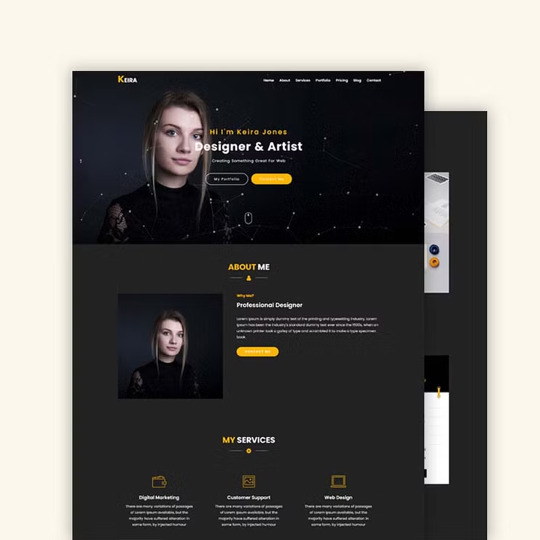
Portfolio Website Template
#personal portfolio html template#html css#designer portfolio#portfolio template#personal portfolio#portfolio website#webdesign#css#html#css3#bootstrap themes#mourithemes#resume#cv
4 notes
·
View notes
Text
Celestial Dreams: A Daily Planner Diary for Inspired Living
"Welcome to 'Celestial Dreams,' your daily companion for inspired living! Embrace the magic of each day with this beautifully designed planner diary, featuring celestial-themed artwork and motivational prompts to fuel your journey towards your dreams. Size - (21cm * 29.7cm) pdf formate
Inside 'Celestial Dreams,' you'll find:
Schedule Section: Organize your tasks, appointments, and priorities for each day, ensuring you stay on track and focused on your goals. Self-Care Section: Cultivate a mindset of gratitude by reflecting on the blessings in your life and expressing appreciation for the little joys. Habits Section: Boost your confidence and motivation with empowering affirmations that inspire positivity and self-belief. Notes Section: Capture your thoughts, ideas, and inspirations in the spacious notes section, allowing creativity to flow freely.
link - https://payhip.com/b/HEAUq
#Daily Planner#Diary#Planner Journal#Inspirational Planner#Celestial Theme#Goal Setting#Gratitude Journal#Affirmations#Productivity Planner#Personal Development#Self-Care#Mindfulness#Motivational Planner#Creative Journal#Wellness Planner#Website Templates#Web Design Templates#Website Design Inspiration#Best Website Templates#Responsive Website Templates#WordPress Themes#HTML Templates#CSS Templates#Free Website Templates#Premium Website Templates#Website Design Trends#Website Layout Templates#Professional Website Templates#E-commerce Website Templates#Portfolio Website Templates
0 notes
Photo

New Post has been published on https://themesnulled.us/dennis-tailwind-css-personal-portfolio-html-template-dark-rtl/
Dennis - Tailwind CSS Personal Portfolio HTML Template + Dark + RTL
0 notes
Text

Harper - Personal Portfolio HTML Template
#harper portfolio template#cv#resume#template#html template#html css#responsive website#personal portfolio
1 note
·
View note
Note
Hi!! I wanted to say that I loved reading about your journey of creating a personal website. I'm still unsure between Vercel and Netlify. I have a small question to ask. See, one of the reasons I want to make a website is to archive drawings and journal/sketchbook. Would you have any tips for creating an area on my website just for the diary/journal, which has tags, files for each entry, etc.?
Bello!

Really happy to hear about your interest in websites! I want everyone to make their own site so I don't have to log into social media and get instant tummyaches ♥
Vercel vs Netlify: I think I settled on Vercel for absolutely no reason whatsoever. I just made a site on Netlify, then tested on Vercel, and now I have like 5 websites on Vercel so I just kept using it LOL. I'm sure a more tech-savvy person would know the difference - I think they have certain integrations with specific programs.
Creating a diary or journal with tags:
There's a couple of different ways you can do that, with different levels of work needed.
you got me yapping again:
This sadgrl tutorial might be outdated and may or may not work, but explains the process better than I can.
Easiest: make a journal on Dreamwidth, or another blogging site (wordpress??) that allows easy tags and RSS feed, and embed that RSS feed onto your site.
This requires almost no HTML set-up, and the easiest to organize tags, but you don't truly have the data on your own site since it's just embedded.
When I snuck into a web design class at college, this was one of the methods that the professor used for a blog within a portfolio site LOL.
Shit like wordpress is what a LOT of ~professional~ sites do for their blog section. They code it separately from the main site haha. It's the most popular thing, but not necessarily the best. And wait til you read on what the CEO of wordpress has been having meltdowns about... he owns tumblr too!
It's made with a tutorial for Neocities if that's what you use.
Medium: Set up zonelets.
It will require some HTML and JS editing, but will help automate making headers/footers for each page of a blog.
I've never used it myself, but I see other people speak highly of it.
HARD FOR ME CUZ I'M A GORILLA: I believe a lot of professional web devs will slap your face with their coding cock until you use a static site generator (SSG) to make your site.
You will need some coding knowledge to set up the tagging system since it doesn't come with it enabled by default. But it's made explicitly to be an alternative to big Static Site Generators which are...
It requires some more intimidating knowledge, because it's a lot of scripts that turn files that are not HTML/CSS/JS into plain HTML.
Also you have to use the command line, and that doesn't come with buttons that tell you what you can do. You have to copy/paste all that shit or memorize the code to 'dev build astro' and it all looks silly.
I've used Eleventy, and now am using Astro. Other people use Hugo or Jekyll or some other stuff with crazy names like Glup Shitto. I hate all these sites cuz none of the words mean anything to me. This is a common theme for me and tech. I don't know what NODES or CONTENT or ISLANDS are!!!
I had the most success attempting to learn how to use a SSG by downloading a template and altering it with github + VScodium. Here's the template page for Astro. You click on a theme you like, and it takes you to its github page. (If you don't want to use evil Microsoft stuff sorry. Skip this entire section.) Follow the instructions on the page for "forking" the glup shitto. When it tells you to run commands, I run those commands through the terminal window in VScodium. These tutorials never tell you what these commands do cuz they assume you already know. Usually those commands automatically install the files you need onto your computer, and create the final files.
You can see my wip here for a "tag system" that SHOULD show members of a web listing haha but I don't know what I'm doing and I have a reading disorder AND don't know cumputer good.
THEORETICALLY this will be the simplest and easiest way to maintain tags and files, because after you set it up you just have to write the "content" of the blog page. And you don't have to set up the header/footer ever again. I see the vision, and potential, but I am not there yet when it takes me 5 hours a day to figure out what any of the words in the documentation mean and I don't want to ask an actual tech person cuz they will be like 'obviously just press the Blip on the Repository and then Suck My Ass in the command line".
(side note I haven't updated fujofans in like a year cuz I'm struggling with this part to make updating easier).
Con: the final HTML/CSS code is really ugly if it's "minified", and a lot of themes use """"""professional"""""" CSS libraries like Bootstrap and Tailwind that I honestly think are ugly cuz that's what every fuckin' tech website uses to style their pages and make them look Professional and Minimalist with stupid code like style="500-w dark-gray-balls D-cup-bra" on every single element. Even Toyhouse uses Bootstrap. Eugh!
But maybe you're smarter than me and can wrangle these things better!
That was really long. Woops. I hope you can slug through this wall of text and find something helpful. Feel free to email me if you have any more specific questions. I may or may not be helpful.
If someone else sees this and has better suggestions for making BLOGS, please chime in. I'm begging you.
64 notes
·
View notes
Note
Hey Krad, do you have any advice for starting a website like yours? I love the idea of starting a website to host my fandom and personal portfolio, and maybe get back a piece of the old internet. How did you put yours together?
hey there! great question, and the good news is there's a lot of ways to go about it.
the bad news is, there's a lot of ways to go about it.
to simplify things, there's kind of ... three "tiers" to the back-end of how to create a website. let's break it down below.
high ease, low customization. (wix, weebly, squarespace, etc. you pay a company + they give you a bunch of themes and pre-made pages for you to drop images in.) can have one of these online in 2-3 hours, but it often "feels" templated and sterile.
medium ease, medium customization. (making a theme from scrach with tumblr's custom code editor, hybrid sites with some pages in pure code, some with wordpress grafted onto some subdomains). this is what i'd classify my site as, as I use wordpress for my logs for brainless updating. while i'm confident coding single/static pages, i just don't have the time or brainwidth right now to make a complex archiving system.
low ease, high customization. (neocities, pure html/css/coding). the downsides to this is oftentimes these sites are not phone-friendly, and there's a steep learning curve. but for the quintessential "old internet" experience, by far the best route to take. there's also something really empowering about learning why things work the way they do.)
some of this can be super intimidating if you're starting from 0 coding knowledge; there's no shame in switching to a templating software. hell i started with weebly and dicking around in tumblr's custom code template for a solid 5 years before making my current site, and that was with a previous 5 years of sketchy html experience) you're not gonna learn everything overnight.
but! as long as you keep a curious and inquisitive mind, you can't go wrong.
one last encouragement: there's kind of a mini renaissance with custom sites right now, especially in neocities circles, so you're kinda in luck in that there's more resources than ever. i love scumsuck's guides, and fancoders (the community) is also all over this too.
good luck!
60 notes
·
View notes
Text
HTML Website Code

Many Website Templates Can Be Created with the Help of HTML Website CodeHTML (Hypertext Markup Language) is the foundation of website development, serving as the backbone for creating and structuring web pages. With HTML, developers can create diverse website templates that cater to various purposes and industries, such as business websites, personal portfolios, e-commerce platforms, blogs, and more. The versatility and simplicity of HTML make it an ideal choice for designing templates that are not only visually appealing but also functional and user-friendly.
#agatha harkness#artists on tumblr#anya mouthwashing#bucktommy#agatha all along#911 abc#batman#cats of tumblr#dan and phil
2 notes
·
View notes
Text
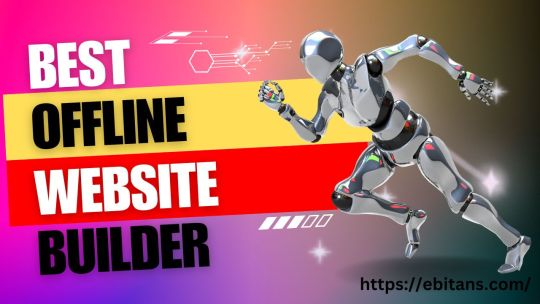
Best Offline Website Builder Software: Building Websites without Internet
In today's world, having an online presence is vital for businesses and individuals alike. Whether you’re a small business owner, a freelancer, or someone looking to showcase your portfolio, having a website is no longer a luxury—it's a necessity. While plenty of online website builders are available, such as Wix, Squarespace, and WordPress, not everyone has access to a stable internet connection. This is where offline website builders come in handy.
Offline website builder software allows you to create, edit, and design websites without being connected to the internet. Once your design is complete, you can publish it online when you’re ready. These tools are excellent for those who prefer to work on their websites offline, whether due to limited internet access or personal preference. In this article, we'll explore some of the best offline website builder software available, and their features, pros, and cons.
Why Choose Offline Website Builders?
Before diving into the best offline website builders, let’s first discuss why you might want to use an offline builder over an online one. There are several reasons why someone might prefer to work offline:
No Need for Constant Internet Access: With offline website builders, you can create your website at your own pace, even if you don’t have a stable internet connection.
Increased Control and Flexibility: Many offline builders allow you to work directly with HTML, CSS, and JavaScript. This provides more control over the design and functionality of your website.
Faster Load Times: Since everything is stored locally, there’s no need to wait for images, templates, or other assets to load over the internet. This can significantly speed up your design process.
Backup and Security: All your website files are stored on your local machine, which means you don’t have to worry about server outages or security breaches affecting your website.
Best Offline Website Builder Software
Now that we understand the benefits of offline builders, let’s dive into some of the best offline website builder software available today.
1. Adobe Dreamweaver
One of the most well-known and robust tools for building websites is Adobe Dreamweaver. A part of the Adobe Creative Cloud suite, Dreamweaver is a powerful tool that allows users to design, code, and manage websites. It is widely used by both beginners and advanced users alike.
Key Features:
Code and Design View: Dreamweaver offers both a visual editor and a text-based code editor. You can toggle between the two as you design your site.
Live Preview: You can view a live preview of your site as you make changes, allowing you to see exactly how it will look once published.
Responsive Design: Dreamweaver makes it easy to create responsive websites that look great on all devices.
Supports Multiple Languages: You can use Dreamweaver to code in HTML, CSS, JavaScript, and more.
Pros:
Highly customizable for developers.
Supports a wide range of web technologies.
Excellent support for responsive design.
Cons:
Steep learning curve for beginners.
Requires a subscription to Adobe Creative Cloud.
Best For: Professional developers and those familiar with HTML and CSS.
2. Mobirise
Mobirise is a free offline website builder software that allows users to create mobile-friendly websites with ease. It’s a great tool for those who don’t have extensive coding knowledge but still want to create a professional-looking site.
Key Features:
Drag-and-Drop Builder: Mobirise uses a drag-and-drop interface, making it easy for beginners to use.
Pre-made Templates and Blocks: The software comes with a variety of templates and content blocks, which you can customize to your liking.
Mobile-Friendly: Websites built with Mobirise are automatically responsive and optimized for mobile devices.
Works Offline: You can work on your website completely offline and then publish it when you're ready.
Pros:
Easy to use for beginners.
Free to use, with optional paid themes and extensions.
Supports Google AMP and Bootstrap 4.
Cons:
Limited customization compared to more advanced builders.
Requires third-party hosting for publishing.
Best For: Beginners and small business owners who need a simple and quick solution.
3. Pinegrow
Pinegrow is a desktop website builder that allows users to create responsive websites using a visual editor. What sets Pinegrow apart is its focus on providing professional web designers and developers with powerful tools while still being accessible to beginners.
Key Features:
Drag-and-Drop Interface: Pinegrow allows users to drag and drop elements onto the page, making it easy to build layouts without coding.
Real-time Multi-page Editing: With Pinegrow, you can edit multiple pages of your site at once, and changes are reflected in real time.
Framework Support: Pinegrow supports popular frameworks such as Bootstrap, Tailwind CSS, and Foundation.
Responsive Design: The builder makes it easy to create responsive websites that look good on all devices.
Pros:
Supports frameworks like Bootstrap and Tailwind.
Suitable for both beginners and advanced users.
Provides a good balance between code-based and visual editing.
Cons:
Some users might find the interface cluttered.
Not as beginner-friendly as other builders.
Best For: Web designers and developers who want more control over their designs without sacrificing ease of use.
4. WYSIWYG Web Builder
WYSIWYG Web Builder is another offline website builder that’s popular among beginners. The acronym stands for "What You See Is What You Get," meaning the design view shows you exactly what your final website will look like.
Key Features:
Visual Editor: You don’t need to know any coding to create a website with WYSIWYG Web Builder. Simply drag and drop elements onto the page.
Pre-made Templates: Choose from a variety of templates and customize them to suit your needs.
Responsive Web Design: Create websites that are optimized for mobile devices.
Extensions: WYSIWYG Web Builder supports a wide range of extensions that can add functionality to your site, such as image galleries, sliders, and contact forms.
Pros:
Easy for beginners to use.
No coding required.
Offers a wide range of pre-made templates.
Cons:
Limited customization options for advanced users.
Some features are outdated compared to more modern builders.
Best For: Beginners who want a simple, no-coding-required website builder.
5. Webflow (with Offline Features)
Although Webflow is primarily an online website builder, it offers a unique option to work offline through its desktop application. Webflow is ideal for designers who want to create sophisticated websites without diving too deeply into code. It combines the ease of a visual editor with the power of custom coding.
Key Features:
Responsive Design: Webflow lets you create fully responsive websites that look great on all devices.
CMS Integration: Webflow has a built-in CMS, making it easy to manage dynamic content like blogs or product catalogs.
Custom Code: For users who want more control, Webflow allows the addition of custom HTML, CSS, and JavaScript.
Offline Capabilities: The Webflow desktop app allows users to work on their designs without being connected to the internet, and then sync changes once they’re back online.
Pros:
Combines visual design with the power of code.
Great for designers and developers who want flexibility.
Offline capabilities through the desktop app.
Cons:
Steeper learning curve compared to drag-and-drop builders.
Premium features require a subscription.
Best For: Designers and developers who need advanced features and offline editing capabilities.
Conclusion
Choosing the best offline website builder software largely depends on your level of expertise, specific needs, and the type of website you want to create. If you're a beginner looking for a straightforward solution, tools like Mobirise or WYSIWYG Web Builder are excellent choices. For more advanced users or those who prefer to have greater control over their design and code, Adobe Dreamweaver, Pinegrow, and Webflow offer the features and flexibility you need.
if you need more information then see more>>>
2 notes
·
View notes
Note
ur website is awesome where did you learn html and css!! ive been looking for months now but i cant find any starting points i can easily understand
Thank you! I kind of mostly used to do Neopets template junk in 2007 and had some extremely basic and outdated HTML knowledge until recently LOL (As in that my knowledge was basically knowing that <i> made your text italic and if I typed color="blue" it would change the color of the text haha)
But yeah, I'm basically self-taught! One of the courses I did in the past did have a few Web Design classes, but I had a really hard time understanding any of it and my grades were awful, so I hardly count that as having contributed anything to my knowledge x) (We were forced to make the most bland minimalistic corporate websites so the lack of fun in that definitely contributed hahaha)
I guess starting out really depends on what you're personally comfortable with? The way I personally started was that I used one of those Free Website Makers like Wix/Weebly/etc to try and "sketch" my website! I had this old unused !Weebly portfolio website I wasn't doing anything with, so I used that
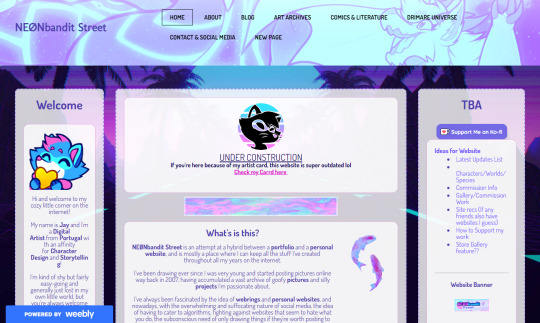
W3Schools is the MVP for this stuff since it has basically everything you can learn about HTML/CSS/etc! For my Website I remember first starting by trying to create the navbar, looking at the Weebly mockup and trying to mentally deconstruct it all into boxes to try and understand how I could recreate it with my own code!
(The reason my navbar looks so different from the screenshot was because I had a really hard time recreating it xD And I ended up with something a lot more basic to match my skillset!)
Something that always worked for me was using templates and just trial and error my way into trying to understand what did what x)
Considering my website has the three-column format, I do recall using SadGrl's Layout Maker code as a reference for my own!
And I guess that's advice I can give?? Finding websites you like, or if you're wondering how someone did something, how their font has weird colours, what animations they're using, etc etc, just go look into their source code, or use the Inspect Tool (F12) and select elements to try and understand the code!
I do sometimes hide goofy hidden text and easter eggs in my source codes, so I'm personally cool with people looking through mine to understand how I did things :)
I definitely relate to this all being overwhelming or confusing at the start, so I'd say just take it slow and make things fun for yourself! I used weird fonts and bright colours when trying to see what does what, use dumb placeholder texts and images too LMAO
Another thing that helped was that I found gifs and images I liked to place on the website and try to make it feel all the more personal and cozy!
Again this is just my personal experience and what I did to make the learning experience more enjoyable :)
#Jay Asks#Anonymous#Neocities Tag#Sorry for the long ramble!#People don't tend to be very receptive to my methods when I share how I do things x) So take it with a grain of salt#I'm very adamant over the Doing what works best for you logic
19 notes
·
View notes
Text
Hire a Web Developer on Fiverr Starting at Just $50

If you’re looking to launch a professional website without breaking the bank, you’re in luck. You can now hire a web developer on Fiverr starting at just $50 — making quality web development more accessible than ever before.
Whether you’re a small business owner, a startup founder, or an entrepreneur on a budget, Fiverr offers a range of talented freelance web developers ready to bring your website to life — all at highly competitive rates.
hire a web developer on Fiverr, affordable web development, Fiverr web , development services, web developers under $50, WordPress development Fiverr, budget-friendly website design, best Fiverr freelancers for web development,
Why Hire a Web Developer on Fiverr?
Fiverr is one of the largest online freelance marketplaces, connecting businesses with skilled professionals from around the world. When you choose to hire a web developer on Fiverr, you benefit from:
✅ Affordable pricing: Starting as low as $50
✅ Wide talent pool: Thousands of vetted developers
✅ Quick turnaround times
✅ Custom website solutions
✅ Transparent reviews and ratings
Whether you need a custom WordPress site, an eCommerce store, or a landing page that converts, there’s a developer on Fiverr who specializes in exactly what you need.
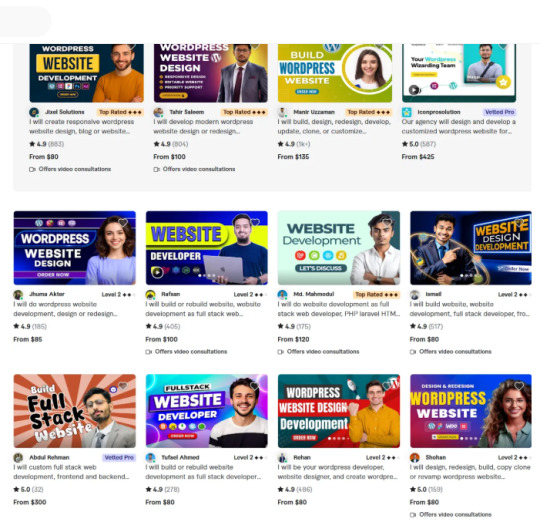
What You Can Get for $50 on Fiverr
You might be wondering what $50 can actually get you. Here are just a few examples of services you can expect at this budget:
✅ Simple 1–3 page WordPress websites
✅ Landing page design and development
✅ Website bug fixes and speed optimization
✅ Basic HTML/CSS site builds
✅ Customization of existing templates or themes
Many Fiverr freelancers offer tiered pricing, so $50 might be their basic package — with additional features available as add-ons.
How to Choose the Right Web Developer on Fiverr
To ensure you get the best results when you hire a web developer on Fiverr, follow these tips:
🔍 Filter by budget and delivery time
📋 Read gig descriptions carefully
⭐ Check ratings and client reviews
🧰 Look at portfolio samples
💬 Message the seller before placing an order
Working with a freelancer who understands your project goals and communicates clearly can make all the difference.
Popular Fiverr Web Development Services
Fiverr developers offer a wide range of services, including:
WordPress website development
Shopify store setup
Wix, Squarespace, and Webflow builds
Frontend development (HTML, CSS, JS)
Backend coding (PHP, Node.js, Python)
Responsive mobile design
Speed optimization & SEO setup
No matter your niche or business type, you’ll find a qualified developer to match.
Final Thoughts: Build Your Website Without the High Costs
You no longer need to spend thousands of dollars or hire a full-time employee to get a functional, professional website. Thanks to Fiverr, you can hire a web developer starting at just $50 and get high-quality results fast.
Take advantage of this affordable solution today and start building your online presence with confidence.
💡 Ready to Hire?
👉 Click here to find top-rated Fiverr web developers starting at $50
Affiliate Disclaimer: This article contains affiliate links. If you click through and make a purchase, I may earn a small commission — at no extra cost to you. I only recommend products and services that I personally believe can provide value. Thank you for your support!
#website development#websitedesign#freelance web designer#freelance web developer#laravel web development services#web developer#web developers#web developer near me#web development services UAE#web development agency#web development UK#web development USA#front end web development company
0 notes
Text
Profile-Pro - Ultimate Personal Portfolio Template
LIVE DEMO | BUY NOW
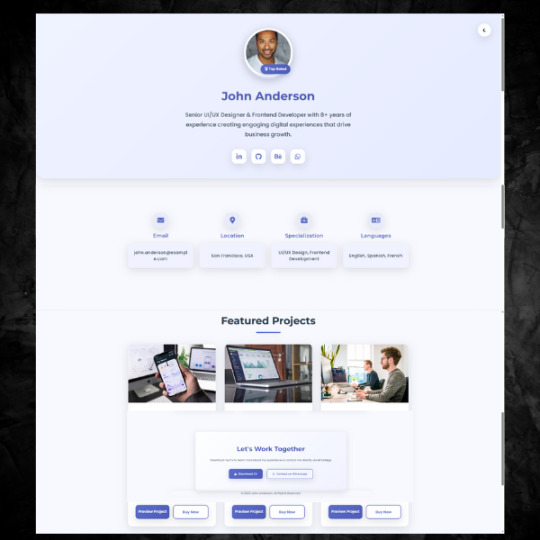
Profile-Pro is a professionally designed personal portfolio template that showcases your skills, experience, and projects with elegance and impact. Crafted for modern professionals who want to make a lasting impression, this template combines aesthetic appeal with functional excellence.
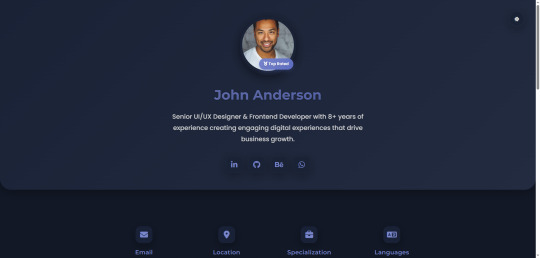
Why Choose Profile-Pro?
Modern Design Aesthetics: Sleek interface with harmonious colors and sophisticated effects
Exceptional User Experience: Perfect contrast, subtle shadows, and smooth transitions
Fully Responsive: Flawless performance on mobile, tablet, and desktop devices
Day/Night Mode: Eye-friendly theme switching with automatic preference saving
Professional Project Showcase: Elegant portfolio section to highlight your best work
Easy Customization: Simple modification to match your personal brand identity
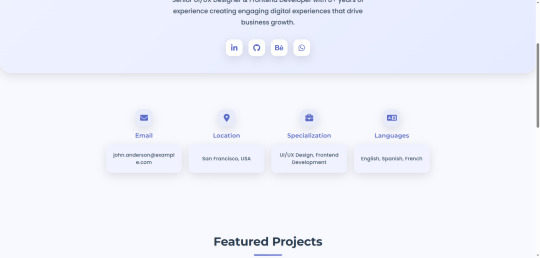
Key Features & Capabilities
Professional Design
Modern UI with sophisticated styling
Harmonious color scheme with customization options
Precise shadows creating depth and elegance
Theme Switching
One-click toggle between light/dark modes
Automatic user preference saving
Seamless design consistency across both themes
Fully Responsive
Adaptive layout for all screen sizes
Consistent user experience across devices
Smart element and text scaling
Project Showcase
Elegant project grid layout
Project cards with impressive hover effects
Clear action buttons (Preview/Buy)

Contact Information
Innovative information card design
Icon-based contact details
Social media integration
Performance Optimized
Lightweight codebase for fast loading
Clean HTML/CSS without frameworks
SEO-friendly structure
License
This template is released under the MIT License - free for personal and commercial use with attribution. See LICENSE file for details.
Quick Start
Download the template files
Customize content in index.html
Replace images with your own
Deploy to any hosting service

Transform your online presence with Profile-Pro - where professionalism meets design excellence!
#css#html#html css#htmlcoding#js#Profile page#landing page design#ui ux design#design#template#template design#landing page#landing page builder#landing pages#panel#coding
0 notes
Text

Portfolio Landing Page Template
#portfolio template#personal portfolio html template#html css#mourithemes#css#html#css3#webdesign#frontenddevelopment#learn to code#landing page template#bootstrap template
0 notes
Text
Creative Coding: Shaping the Future of Web Development in Ahmedabad
In the fast-moving digital age, websites are more than just online brochures; they're interactive platforms that shape customer experiences, build trust, and drive sales. And as businesses increasingly rely on the web to connect with users, web development services in Ahmedabad are taking center stage.
Ahmedabad, once known primarily for textiles and heritage, is now a thriving digital innovation hub. From startups to large enterprises, businesses across industries are turning to skilled web developers to create visually stunning, high-performance websites that stand out in crowded digital spaces.
But what’s powering this transformation? The answer lies in creative coding, a fusion of logic and design, where web developers blend technical expertise with artistic thinking to craft unforgettable digital experiences.
In this article, we’ll dive deep into how creative coding is revolutionizing web development services in Ahmedabad, the tools and trends leading this evolution, and why businesses can’t afford to ignore it in 2025 and beyond.
What Is Creative Coding?
Creative coding refers to the practice of using code not just to make websites function—but to make them come alive.
This approach combines traditional development skills (like HTML, CSS, JavaScript, backend logic) with artistic elements like animation, interactivity, 3D visuals, and custom graphics. The result? Websites that don’t just inform but wow visitors.
Instead of static, templated layouts, developers use creative coding to:
Animate elements as users scroll
Build immersive storytelling pages
Integrate motion graphics or WebGL
Create responsive interactions based on user behavior
This style of development is transforming how users engage with websites and Ahmedabad is quickly emerging as a hotspot for this new digital craft.
Why Ahmedabad? The Rise of a Digital Powerhouse
Ahmedabad didn't become a digital tech hub in a day. Over the past 10 years, the city has gone through:
A surge in IT parks and startup incubators
Skilled tech graduates from institutes like Nirma University and DAIICT
Affordable cost structures for development work
Global clientele outsourcing to Ahmedabad-based firms
Strong support from the Gujarat government’s Digital India push
These factors have created the perfect ecosystem for innovation in web development.
Today, you’ll find Ahmedabad-based agencies building everything from corporate websites and eCommerce platforms to interactive art portfolios and immersive storytelling websites all powered by creative coding.
How Creative Coding Is Changing Web Development
Let’s explore how creative coding is driving the next wave of web development services in Ahmedabad.
1. Immersive User Experiences
Gone are the days of static websites. Now, users want dynamic, scroll-triggered animations, 3D visuals, and micro-interactions that feel smooth and engaging.
Developers are leveraging:
GSAP (GreenSock Animation Platform) for fluid animations
Three.js for creating 3D elements in-browser
Framer Motion and Lottie for stunning motion effects
With these tools, Ahmedabad-based developers create memorable digital journeys that reflect brand identity and hook users within seconds.
2. Personalized Interactions
Today's websites monitor user behavior and adjust the experience instantly to match their needs.
Creative coding allows developers to:
Change visuals based on user location or behavior
Load content dynamically
Build intelligent interfaces that “talk” to the user
Use parallax effects and scroll-based animations for storytelling
These enhancements increase dwell time and conversion rates especially for brands in fashion, tech, education, and hospitality.
3. Cross-Device Consistency
Whether someone visits your site on a laptop, tablet, or mobile, the experience needs to feel seamless. Creative coders optimize everything from loading speed to touch gestures.
Using responsive frameworks and creative logic, they ensure:
Layouts adapt fluidly across devices
Animations feel natural on all screen sizes
Touch-based interactivity is smooth and intuitive
This commitment to design thinking sets Ahmedabad’s developers apart from generic, template-based solutions.
4. SEO and Performance Are Still Key
While creativity is important, performance and SEO can’t be ignored. That’s why the best web development services in Ahmedabad follow Google’s Core Web Vitals and SEO guidelines, ensuring:
Fast load times
Optimized assets (images, fonts, videos)
Proper HTML semantics for accessibility
Structured metadata and schema markup
Clean, secure, scalable code
In other words, you get beauty and brains in one package.

Real-World Use Cases from Ahmedabad
Let’s look at how creative coding is helping real businesses in Ahmedabad:
An Art Gallery Website
Using JavaScript canvas and WebGL, developers built an interactive gallery with 360° views of artwork, real-time zoom features, and hover-triggered animations.
Fashion eCommerce Store
A Shopify-based fashion brand worked with a creative team to develop animated lookbooks, AR try-on features, and personalized styling tips, resulting in a 35% increase in average session time.
Healthcare Platform
A hospital worked with a web development company in Ahmedabad to build a platform that included animated patient onboarding, a live chatbot, and support for multiple languages making it easier to connect with patients in rural areas.
Tools Used by Creative Coders in Ahmedabad
Here's what’s commonly used:
HTML5 & CSS3 – for structure and advanced styling
JavaScript/TypeScript – core scripting language
React.js & Vue.js – for building interactive UI
GSAP & Anime.js – for professional animations
Three.js & WebGL – for 3D visuals
TailwindCSS & Bootstrap – responsive design frameworks
Figma/Adobe XD – UI/UX design prototyping
Headless CMS (e.g., Strapi, Contentful) – for scalable content
The use of these tools reflects a global standard making Ahmedabad developers competitive worldwide.
Why Businesses Should Choose Web Development Services in Ahmedabad
So why should you consider hiring from Ahmedabad?
Cost-effective without compromising quality Wide talent pool with up-to-date tech skills Experience in both Indian and international markets Strong focus on design + functionality Quick turnaround time and reliable communication
From startups looking to launch MVPs to enterprises seeking robust portals Ahmedabad delivers scalable solutions with creative flair.
How to Choose the Right Development Partner
Not all agencies are created equal. To make the most of your investment, look for a web development partner who:
Offers end-to-end service
Has a strong portfolio of creative, performance-optimized websites
Uses modern tech stacks and is open to new innovations
Communicates well and meets deadlines
Understands your industry and goals
A reliable web development company in Ahmedabad will not just execute your idea, they'll elevate it.
FAQs
1. How much do web development services in Ahmedabad cost?
It depends on complexity, features, and design requirements. Basic websites may cost ₹20,000–₹50,000. Custom interactive sites can range from ₹1 lakh to ₹5 lakh or more. Always request a detailed quote.
2. How long does it take to build a creative website?
A simple static site may take 1–2 weeks. A creative, custom-coded site with animations and integrations may take 4–8 weeks depending on feedback cycles and revisions.
3. Will my website be mobile-friendly and SEO-optimized?
Yes. Top web development services in Ahmedabad ensure websites are responsive, SEO-ready, and aligned with Google’s performance metrics like Core Web Vitals.
4. What industries can benefit from creative coding in web development?
Creative coding adds value across industries fashion, education, healthcare, travel, SaaS, art & culture, architecture, and more. Any business that values engagement and first impressions can benefit.
Final Thoughts
Web development isn't just about making websites anymore it's about creating engaging user experiences. And web development services in Ahmedabad are leading this movement by combining code with creativity, logic with design, and aesthetics with performance.
Whether you’re launching a new brand, reimagining your online presence, or scaling your digital operations, don’t settle for templates or boring designs. Step into the new age of web development, where each line of code helps shape a unique story.
Let Ahmedabad’s creative developers shape your brand’s next chapter on the web.
0 notes
Text
Building a Personal Website: Why It Matters for Your Career
Why build a personal website? Simple — because your online first impression matters more than ever. Try Goggling your name. What shows up? For most people, it’s a scattered mix of LinkedIn profiles, social media posts, and maybe an old photo from college. But imagine if, right at the top, a sleek personal website popped up — your own digital space, crafted by you. That’s how you stand out. It’s the smart way to boost your visibility and set the stage for real career growth with website power.

Now let’s dig into why having a personal website is becoming a must-have, especially if you’re in tech, design, writing, or any career where showing your work speaks louder than a résumé.
Show, Don’t Just Tell — The Portfolio Power Move
You know what’s cooler than saying “I’m a web developer”? Showing a slick site you built with your own code. When you showcase portfolio online, you’re not just listing skills, you’re proving them. A website lets you display your projects, case studies, testimonials, and all the tech you’ve touched — right in one clickable place.
And the best part? You control it. No weird layout restrictions or profile updates lost in a sea of job boards. You get to highlight your personal branding for developers, writers, marketers — whoever you are. That brand is you, and your website is your 24/7 personal hype machine.
Still wondering why build a personal website? Think of it as your home on the internet. Social media platforms come and go, but your domain name sticks with you. It’s your turf, your vibe, your digital legacy. Future you will thank present you.
Boost Career Confidence and Get Found
Here’s a fun fact: recruiters and clients Google candidates. All. The. Time. Now, imagine their surprise when they find a sleek, updated site with your story, your work, and a killer blog on career tips. That’s a chef’s kiss moment.
This is where career growth with website gets real. Your personal site doesn’t just display your work — it increases your chances of being found online. Add some smart keywords (like “JavaScript developer in Seattle” or “UX designer with SaaS experience”), and suddenly you’re on someone’s radar.
A well-built website can be the ultimate web development career tip in disguise. You show off your tech stack, your creativity, and your communication skills — all in one go. And if you’re using the Coding Brushup personal website guide, you’re setting yourself up for a smart, structured, and polished result.
Stand Out, Stay Sharp, and Get Hired
Having your own website screams, “I take my career seriously.” It’s a subtle yet powerful signal that you’re proactive, organized, and resourceful. You’ve taken the time to craft your online presence — not just throw together a résumé. That’s a big green flag for clients and hiring managers alike.
And guess what else? It sharpens your skills. Whether it’s HTML, CSS, writing copy, or organizing a portfolio, building your site forces you to level up. It’s hands-on learning at its best. This is one of those personal website benefits that people often overlook: you grow while building it.
Plus, you can blog! Share insights, document projects, write about your coding journey or challenges you’ve faced. With each post, you’re not only helping others — you’re showing thought leadership. And yep, that’s another boost for your career growth with website as a tool.
Final Thoughts from Coding Brushup
If you’re serious about building your tech career, a personal website isn’t optional anymore — it’s your secret weapon. And no, it doesn’t have to be fancy. Even a simple, clean site with your name, projects, contact info, and a few fun facts can set you apart.
Need help getting started? The Coding Brushup company website has tutorials, templates, and guides designed to walk you through each step. Whether you’re a total beginner or a dev brushing up on skills (hey there, Codingbrushup personal website guide fans!), we’ve got your back.
So grab a domain, pick a template, and start building. You’re not just creating a website — you’re investing in you.
0 notes
Text
How to Choose the Right Team for Your Website Project
Launching a successful website in 2025 is no longer about simply picking a template and filling it with content. Whether you're creating an eCommerce store, a SaaS platform, or a content-rich publication, you need a highly skilled, cohesive team to bring your vision to life.
Choosing the right team for your website project can be the difference between a smooth, efficient launch and a frustrating, costly disaster. In today’s post, we’ll break down what to look for in a website development team, how to align your goals with their expertise, and why businesses often turn to the top WordPress plugin development companies for scalable, customized solutions.
Why the Right Team Matters More Than Ever
Modern websites are expected to be:
Fast-loading
Mobile-responsive
Secure
SEO-optimized
User-friendly
Achieving all of these goals requires a blend of technical and creative talent. You need strategists, developers, designers, content creators, and marketing experts all working together in sync. A weak link in any of these areas can drag down the entire project.
That’s why choosing the right development team isn’t just a hiring decision—it’s a business strategy.
Define Your Website Goals First
Before reaching out to developers or agencies, clarify your goals:
Are you selling products, services, or subscriptions?
Do you need integrations with third-party tools (CRM, email, etc.)?
Will the site feature custom functionality like booking systems or learning modules?
Do you need a CMS like WordPress, or a custom-built platform?
Once your requirements are clear, it’s easier to find a team with the right mix of skills to match.
Key Roles You Need on Your Website Project Team
An effective web project team typically includes:
1. Project Manager
They’re the point person for timelines, communication, and coordination. A good PM ensures the project stays on track and within scope.
2. UI/UX Designer
Designers handle the look and feel of the site, but also focus on user experience—how easy and enjoyable it is to navigate.
3. Front-End Developer
They bring the design to life, building the user-facing part of your website with HTML, CSS, JavaScript, and frameworks like React or Vue.
4. Back-End Developer
They handle the server-side logic, database management, and site functionality. This role is critical for custom features or plugin development.
5. QA/Testers
These team members test for bugs, performance issues, and usability problems to ensure your site works smoothly across devices and browsers.
6. SEO & Content Strategists
They optimize your content and structure for visibility in search engines—critical for organic growth.
What to Look for in a Development Team
Here’s what separates average teams from great ones:
✅ Proven Experience
Look for case studies, portfolios, and real-world examples of past work—especially those similar to your industry or goals.
✅ Communication Skills
The best teams offer transparent communication, proactive updates, and use collaboration tools (Slack, Trello, Asana) effectively.
✅ Scalability
Can they handle growth or future phases of your website? Look for teams that have supported businesses through multiple iterations.
✅ Custom Development Capabilities
If your website will rely on advanced features, you’ll need developers skilled in custom solutions. Many businesses hire from the top WordPress plugin development companies to build features that standard themes and plugins can’t offer.
✅ Ongoing Support & Maintenance
Post-launch support is often overlooked. Choose a team that offers ongoing maintenance, updates, and troubleshooting.
Freelancers vs. Agencies vs. In-House Teams
Here’s a quick breakdown of your options:Team TypeProsConsFreelancersAffordable, flexibleMay lack coordination, limited scopeAgenciesFull-service, experiencedHigher cost, potential for generic solutionsIn-houseFull control, dedicated teamExpensive to hire and retain
If you're looking for custom plugin work or unique site functionality, agencies—especially those listed among the top WordPress plugin development companies—often provide the perfect balance of skill, scalability, and reliability.
Red Flags to Avoid
When selecting a development team, be cautious of:
Lack of documentation or contract clarity
Vague pricing or hidden fees
No dedicated point of contact
No defined QA process
One-size-fits-all solutions
Overpromising without explaining how
Trust your gut—if communication feels off during early conversations, it’s unlikely to improve later.
The Value of Custom Plugin Development
If your website runs on WordPress and requires special features (custom dashboards, booking logic, unique user roles, etc.), hiring professionals who specialize in plugin development is essential.
Partnering with the top WordPress plugin development companies ensures your plugins are:
Secure and optimized
Future-proof with WordPress core updates
Built to integrate smoothly with themes and third-party tools
Designed to enhance performance, not hinder it
Many of these companies also offer white-label services, giving agencies the power to scale their offerings under their own brand.
Questions to Ask Before Hiring
Don’t finalize your team without asking these key questions:
Can you show relevant work similar to my project?
Who will be my point of contact, and how often will we communicate?
What happens if the project goes over budget or takes longer than expected?
Do you provide post-launch support?
What’s your process for testing and QA?
Can you build custom plugins if needed?
The right answers will tell you if the team is just capable—or truly invested in your success.
Wrapping Up
Your website is the foundation of your online presence. Choosing the right development team is one of the most important decisions you’ll make—and one that can directly impact your brand’s credibility, customer experience, and growth potential.
Whether you go with an in-house team, freelancers, or one of the top WordPress plugin development companies, take the time to vet your options, ask tough questions, and align your goals with their capabilities.
Because when the right team is in place, your website becomes more than just a digital space—it becomes a powerful business asset.
0 notes
Text
Matias - Personal Portfolio HTML Template download
Matias is a creative and unique CV/resume template for developers, designers, programmers, freelancers, writers, lawyers, musicians, trainers, photographers, or any other professions and can be used for Personal Pages. This template contains a single page and multiple pages with a clean & smooth design. Each element of this design is fully creative. The HTML files are fully customizable and all…
0 notes